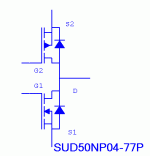Trench-FET for linear audio
Datasheet
Isn't it the Trench-FET that suffers more from channel length modulation effects or is the parasitic capacitances? I remember there was some reason for not using them for linear application but I'm not for sure what it is. I believe Mr. Cordell once made reference to it somewhere here in DIYaudio land.
I believe Mr. Cordell once made reference to it somewhere here in DIYaudio land.

Datasheet
Isn't it the Trench-FET that suffers more from channel length modulation effects or is the parasitic capacitances? I remember there was some reason for not using them for linear application but I'm not for sure what it is.
 I believe Mr. Cordell once made reference to it somewhere here in DIYaudio land.
I believe Mr. Cordell once made reference to it somewhere here in DIYaudio land.Great for switching applications - load switching, SMPS etc. I don't think the state of the art in these areas (especially power supplies) would be where it is today without this technology. For audio - only use them in class D.
You have to choose your TrenchFET's carefully because they come in many flavours nowdays - optimised for switching speed (with about 4 or 5 different flavours in this area alone depending on power supply topology), Rds(on) for load switching as tyically used in auto applications, body drain diode recovery optimised devices etc etc.
There has been a lot of effort to reduce the die size of these trench devices over th e last 10 years or so to reduce cost. So a typical trench device has a much smaller die area than an equivalent lateral or vertical device. This translates into weak linear power handling capability when compared to the older mosfet technologies.
For audio, best to stick with laterals and verticals
You have to choose your TrenchFET's carefully because they come in many flavours nowdays - optimised for switching speed (with about 4 or 5 different flavours in this area alone depending on power supply topology), Rds(on) for load switching as tyically used in auto applications, body drain diode recovery optimised devices etc etc.
There has been a lot of effort to reduce the die size of these trench devices over th e last 10 years or so to reduce cost. So a typical trench device has a much smaller die area than an equivalent lateral or vertical device. This translates into weak linear power handling capability when compared to the older mosfet technologies.
For audio, best to stick with laterals and verticals
. . . for any switching application, like class D, they cannot be bettered.
For linear applications . . . . go lateral or vertical.
For linear applications . . . . go lateral or vertical.
I have tested T-fets in a 475 ampere H-bridge.EWorkshop1708 said:Use them for complementary H-bridge?
- Status
- Not open for further replies.
- Home
- Amplifiers
- Solid State
- Dual TrenchFET's anyone?
